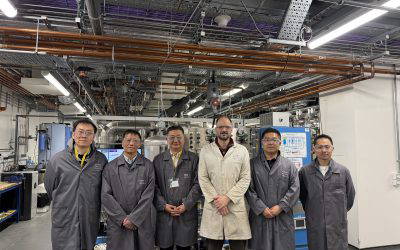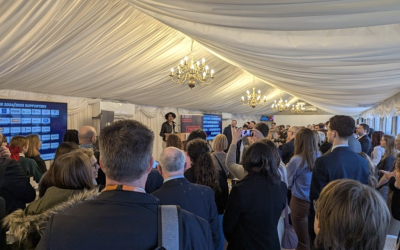On June 22nd and 23rd, the North-East Branch, in conjunction with NEIMEE, held a highly successful conference and exhibition entitled ‘Integrity Engineering for a Sustainable Future (IESF) at the magnificent Neville Hall in the centre of Newcastle. Over 60 guests attended this special event, coming from all over the UK and as far afield as Scandinavia and The Netherlands. All enjoyed a full day of presentations, followed by field trips on the second day. In between the work, there were plenty of opportunities to network, and a gala dinner was held at the end of the first day and greatly enjoyed by all.
The conference was held in the well conserved, grade II listed, Neville Hall, which dates back to the 1860s. Neville Hall is the head office of the North of England Institute of Mining and Mechanical Engineers (NEIMEE) which partnered with the NE Branch in hosting the conference. The rooms in Neville Hall still have their original features (see photos). The lecture theatre and library are particularly impressive, and not many industrial conferences have been held in such remarkable buildings.
Past President Trevor Osborne opened the conference and was closely followed by keynote speaker Prof Jon Gluyas of Durham University, who gave an insightful and humorous presentation entitled “Energy: a sustainable future built on an unsustainable past” commenting on the links between population growth and energy requirements and commenting on possible sustainable sources of the energy required.
A busy day saw a further nine presentations (see table), informatively covering a wide range of topics from carbon capture and storage to wind energy. Topics included new construction, repurposing’ and repair. Old and new technologies were
discussed in terms of sustainability, from solid anodes to drone repair of wind tower blades.
1. Energy – A Sustainable Future Built on an Unsustainable Past. Prof. Jon Gluyas – Durham Earth Sciences
2. CCS Corrosion and materials selection overview and challenges, the approach of an integrated energy company. Roberto Morana – BP – Net Zero Teesside
3. How do you take sustainability into account during design? Birit Buhr – European Energy
4. Advances in wind blade coatings and testing. Edvard Daehlen – Carboline
5. Mitigating Environmentally and Sustainability Impacts of Cathodic Protection in Seawater. Winston Shepherd – Impalloy Ltd
6. Flying Drone Repair of Wind Turbine Blades – Better, Safer and Faster. Chris Kirby – Reblade
ApS – Denmark
7. Addressing hydrogen pipeline repurposing safely & economically. Daniel Sandana – Rosen Group
8. Non-Destructive Testing Challenges in the Net Zero World. Dr Patricia M Conder – ESR Technology Ltd
9. Development of coatings to last the life of the Asset. Willem Horn –AkzoNobel
10. Why paint when you can patch with Easy Qote. Dinko Cudic – Seal for Life Industries
The first day culminated with a conference dinner in the old library, a magnificent room, with books stored behind wooden doors and a gallery reached by ladder to access books stored higher up on the wall. An opening address was given by Trevor Osborne and the meal closed with some final encouraging words from current ICorr President Stephen Tate.
The second day was made up of two site visits in the nearby town of Blyth. Ore Catapult is the UK’s leading technology innovation and research centre for offshore renewable energy. The visit was hosted by Tom Chaplin, Marketing Manager at Ore Catapult.
Their modern facility in Blyth includes an impressive 100-metre-long testing hall capable of testing the biggest wind blades, with plans to increase the capacity as blade size continues to increase. The site also has test facilities for wind turbine powertrains with a capacity of up to 15 MW. Away from the wind turbines themselves, they also have the DARE Digital, Autonomous, and Robotics Engineering Centre.
The second tour was to Bates Colliery, hosted by Charlotte Adams, Principal R&D Manager for Mine Water Heat at The Coal Authority. Bates Colliery is one of a network of disused mines in the north-east where water is being pumped out in large quantities to control the water levels in the mine network.
Using solar power, the water pumped up is treated, settled, and filtered through natural reed beds before being released into the River Blyth. Due to the depth of the mine, the water comes up warm and could be used to generate 5 MW of geothermal energy—a good example of a sustainable legacy from what is considered a polluting industry. Going forward, it has the potential to develop 5 MW of electricity from the groundwater, enough to power the local school.
Ore Catapult is the largest R and D Test centre for wind turbines in the world, currently testing 100 m blades but looking to increase length capacity by 50%. Already, it’s so large that you can drive a double-decker bus in at the end. An incredible facility that tests gearboxes the size of which you can’t imagine, and to see them close-up was breath taking.
This is all wrapped up by “Energy Central,” a partnership of all the Net Zero related businesses; one of the initiatives being to establish and promote local skills to meet the demand.
A fantastic example of the transition from ‘Unsustainable to the Sustainable’.
The North-East Branch Committee wishes to thank all attendees and organisers who made this such a successful and memorable event and hopes the conference demonstrated the opportunities for ICorr in the North-East. A special welcome also goes to our new NE Student ICorr members who actively participated on both days.
After a short summer break, the committee will turn its thoughts to some of the many questions asked after the conference: “Will there be another?” Can we have a NE Christmas Dinner?” “When are the next technical events?” Any interested sponsors should contact nechair@icorr.org
The NE Branch would like to thank all of the sponsors and exhibitors who made the conference possible; Carboline, AkzoNobel, Reblade, Safinah, Metec, Corrosion Integrity Management and The Royce Institute.
*Organising Committee, Matt Fletcher (Chair), Josie Watson (Treasurer), Bruno Ravel, Barry Turner, Patrick Johnson, Simon Daly, Andrew Dobrzanski and David Mobbs with a special thanks to Dr David Bell who expertly controlled all the IT and recordings on the day.
All of the presentations can now be viewed on the ICorr or NEIMME websites.
Please refer to the ICorr Website: North East Branch – Institute of Corrosion (icorr.org) under Local Technical Programme 2023.
CAPTIONS:
Keynote speaker Prof Jon Gluyas of Durham University.
Networking with Exhibitors.
Summary of Technical Presentations.
Conference guests at Dinner in the Magnificent Neville Hall Library.
Guests await Site Visit Registration at Newcastle Central Station
Delegates at Ore Catapult site visit outside the Blade Test Hall and nearby Monopile Testing Facility.
Pumps at Bates Colliery.
Reed Beds before River Blyth discharge.
The Digital, Autonomous and Robotics Engineering (Dare) Centre at the Offshore Renewable Energy (ORE) Catapult’s testing facility in Blyth.



